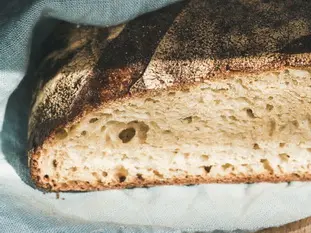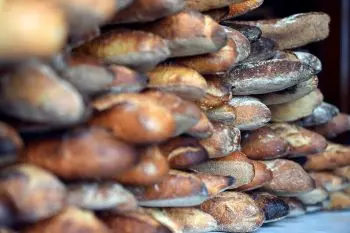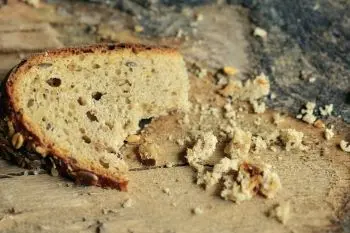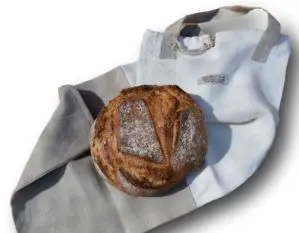This site uses only a few technical cookies necessary for its operation. By continuing to browse, you accept their use.
To find out more...
To find out more...
The preservation of bread

Eating fresh bread is always a delight, the crust crumbles deliciously, you take full advantage of the taste of your bread (80% of this taste is in the crust), it is a fleeting moment to enjoy.
Who hasn't already eaten the crouton or croutons of his baguette, on the way back from the bakery?
Unfortunately, after a few hours, it gets a bit spoiled, the bread naturally softens, and later on it dries out again.
Let's see what happens and how to try to limit it.
Who hasn't already eaten the crouton or croutons of his baguette, on the way back from the bakery?
Unfortunately, after a few hours, it gets a bit spoiled, the bread naturally softens, and later on it dries out again.
Let's see what happens and how to try to limit it.
14 K 4.7/5 (14 reviews)
Keywords for this post:BreadPreservationBakingBagCanvasCottonLinenCrustCrumbLast modified on: June 11th 2022
The preservation of bread
Out of the oven

It cools down slowly, especially if it is a big piece, and for the moment it remains crispy, no secret it is the best time to taste it!
With time comes the staling
Then, as time goes by, some of the moisture that is contained in the heart of the bread by the cooking, will slowly migrate from the crumb (center) to the crust (periphery), it does not change its taste, but the crust softens and the initial crispness goes away...You can't do anything against that, it's in the order of things in baking, but note that it's not as fast on a well or very well baked bread, as on a poorly or under baked one.
It must even happen, in time, the bread must evacuate some of its water otherwise it becomes elastic.
This softening is also accentuated by a poor quality of bread (flours, workmanship, fermentation), you may have already seen those tragic undercooked and softened baguettes, with which it is possible to tie a knot without breaking it.
But no bread escapes it, that's how it starts to stale more or less quickly: It ends up losing almost all its internal moisture to become dry.

What to do?
As I said, we cannot prevent, but we can limit, a little, the staling in time, here are some tracks:- I have already mentioned it, but it is important to remember, a well baked bread will keep longer than a bread that is not
- A sourdough bread will keep better and longer than a yeast bread
- A well-baked sourdough bread, even better.
- Once the bread has cooled down (this is very important), you can store it in something closed, the ancients used a bread bin, a kind of wooden box lined with cloth, and we would tend to use a plastic bag now.
It's a mistake to use a plastic bag, because it keeps your bread soft, but it quickly becomes rubbery, and your bread needs to breathe anyway.
A much better solution is a canvas bag (cotton, linen...), it keeps your bread in good conditions, letting it breathe without letting it completely dry as if it was in the open air.

Dry bread?
If you find yourself with dry bread one day, don't throw it away, in fact we should never throw away bread, it was just unthinkable with my grandparents' generation.Here are a few ways to use it anyway:
- There is dry and dry, put it in the toaster, and what you thought was dry might become soft enough for a breakfast sandwich
- Dry enough? Make French toast out of it, or quiche, or croutons
- Too dry? Turn it into homemade breadcrumbs
To sum up: Staling and drying of bread is normal, but you can limit staling by storing bread in a canvas bag (not plastic).
Lasts posts
Butter vs. grease
We often read in a recipe where a pastry is put into a mould that, just before pouring, the mould should be buttered or greased. But what's the difference between these 2 terms?December 1st 20251,1205
Getting out of the fridge early
Very often when you're cooking, you need to take food or preparations out of the fridge, to use them in the recipe in progress. There's nothing tricky about this: you just take them out of the fridge and use them, usually immediately, in the recipe. But is this really a good method?November 24th 20251,1785
Who's making the croissants?
When you look at a bakery from the outside, you naturally think that in the bakery, the bakers make the bread, and in the laboratory, the pastry chefs make the cakes. It's very often like that, with each of these professions having quite different ways of working, but sometimes there's also one...November 23th 20251,077
Oven height
When we put a dish or cake in the oven, we naturally tend to put it on the middle shelf, and that's what we usually do. But in some cases, this position and height can be a little tricky, so let's find out why.October 8th 20252,9085
The importance of sieving
In recipes that use a fine powder (flour, powdered sugar, etc.), you'll often see the advice to sift before using it. To sift is to pass the powder in question through a sieve (a very fine strainer) before incorporating it into your recipe. It's often advice, but is it really useful?September 3rd 20257,6383
Other pages you may also like
The window-pane test in bread-making
The home bread-makers often ask themselves “Have I kneaded my dough long enough?” . A good question, as dough that is insufficiently kneaded will not rise properly or will fall flat when the top is slashed, which is very frustrating. To know when the dough is ready, one can rely on the length...June 16th 202197 K 23.9
Making the most of seeds: Dry roasting
In cooking, and particularly in baking, there are a lot of seeds we can use, such as linseed, sesame, poppy, etc. Usually, recipes simply say to add them just as they are to the mixture or dough. To make a seeded loaf, for example, prepare a plain bread dough as usual, then, towards the end of...January 30th 201562 K4.0
Artichoke stalks
When preparing artichokes for cooking, you may well already know that we often need to remove the first round of leaves, if they are tatty or dirty, as well as the inedible stalk. The operative word here is “remove” , rather than “cut off”.October 25th 201653 K4.3
Perpetual stock
It's something you have probably have done yourself: cooked or pre-cooked vegetables before adding them to a recipe. This is almost always done the same way: peel the chosen vegetables (carrots, for example), cut them up, boil them in salted water (using a tablespoon or so of coarse salt per litre),...November 22th 201631 K5
Candied fruits: don't get ripped off
Do you like candied fruit? You might like to nibble a handful or add it to a recipe, like a classic fruit cake or delicious Italian specialities like panettone or sicilian epiphany pie.June 21th 201767 K 24.2
Post a comment or question
Follow this page
If you are interested in this page, you can "follow" it, by entering your email address here. You will then receive a notification immediately each time the page is modified or a new comment is added. Please note that you will need to confirm this following.
Note: We'll never share your e-mail address with anyone else.
Alternatively: you can subscribe to the mailing list of cooling-ez.com , you will receive a e-mail for each new recipe published on the site.









